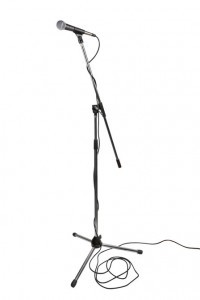Misconceptions about simultaneous interpretation abound: let’s try to dispel the most common ones:
1 – Our counterparts speak English, so they will understand.
 It is a common misconception indeed. Some have excellent command of English and interpreters are not needed. Devil is, however, in details. People may think they are communicating, but then it instantly breaks down and they discover deep differences or a cultural chasm.
It is a common misconception indeed. Some have excellent command of English and interpreters are not needed. Devil is, however, in details. People may think they are communicating, but then it instantly breaks down and they discover deep differences or a cultural chasm.
Even though the interpreter does not guide or direct the conversation in any way, he is a professional cross cultural facilitator and it is his goal is to insure the parties are really communicating. Simultaneous interpretation is not merely repeating words.
2 – My dog/cat/hamster can do it, it is just talking.
Unless it is from Cattese into Doggese (a tough market, not very diplomatic language too), then no! The situation here is similar to speaking a foreign language. One can have a very decent command of Spanish, for example, but ask that person to talk in Spanish about something that is outside of his area of expertise, shall we say…nuclear reactors.
Being able to interpret in simultaneous or consecutive mode is a skill entirely different from speaking a foreign language. An interpreter has to have near native command of all his or her working languages, but on top of that, there is a totally different set of skills related to interpretation itself.
 Bilinguals do not have connections between their foreign languages, it is one of the reasons why it is so difficult for them to interpret.
Bilinguals do not have connections between their foreign languages, it is one of the reasons why it is so difficult for them to interpret.
Interpreters on the other hand take years and decades to build an elaborate network between their working languages and are able to switch between them instantly and find the correct word or phrase not just for everyday conversations but for dozens of specialized topics in politics, history, science, technology, finance, etc.
Once again, it is something that is very different from just being able to speak a foreign language even in your area of expertise!
3 – You can interpret any text and any topic simultaneously.
No. The first thing students have to learn is that simultaneous interpretation as a form of cross cultural communication has its own constraints. Simultaneous interpretation is possible because human languages are to a significant degree redundant and it allows the interpreter to use that redundancy on different levels to analyze the message and perform the interpretation.
Some texts are too dense, too saturated with technical information or are simply said too quickly to be able to interpret them fully, for example a 250 words per minute car commercial. Remember about that when you prepare and deliver your presentation.
An expert interpreter will almost always be able to give a summary, but there may not be enough time to show the beauty of the original and present its best side in interpretation.
How well the interpreter knows the topic also plays a huge role in how good the interpretation will be, that is why interpreters spend so much time preparing for their assignments.
Keep that in mind as well and provide preparation materials in advance: it is in your own interest as a speaker.
4 – I need only 1 simultaneous interpreter. Why do you say I need 2 or 3 per language?
 If it is not over 30 minutes then yes. However, quality of simultaneous interpreting begins to deteriorate rapidly after 30 minutes, so only a gray market interpreter who does not care about the quality he produces would agree to work alone for an entire day.
If it is not over 30 minutes then yes. However, quality of simultaneous interpreting begins to deteriorate rapidly after 30 minutes, so only a gray market interpreter who does not care about the quality he produces would agree to work alone for an entire day.
It is a question of professional responsibility and providing an honest service. Some large international employers actually insist on using 3 interpreters per language in each booth to guarantee quality of service.
5 – Translators are interpreters and interpreters are translators.
These are two entirely different professions and few people are equally good at both. Written translation requires a different temperament and a different set of skills. In interpretation you cannot delete and edit, if it is said it is said. Remember that “translators” work with written text and “interpreters” with oral speech.
6 – We cannot afford to hire a professional simultaneous interpreter. It is the interpreters AND the equipment AND…
Quality professional interpretation services is an asset not a liability, if you look at it as a chore or a black hole that swallows your money you really do not see the benefits.
 The real question is: how critical is the project for you. Do you want it it to succeed or at least do you want to know you did everything for it to succeed? In that case take the danger of miscommunication out of the equation. Do you really want your entire conference fall apart because people who came here from half the world away cannot understand each other? It is your choice as a client.
The real question is: how critical is the project for you. Do you want it it to succeed or at least do you want to know you did everything for it to succeed? In that case take the danger of miscommunication out of the equation. Do you really want your entire conference fall apart because people who came here from half the world away cannot understand each other? It is your choice as a client.
Simultaneous interpretation is a small part of your event budget but we think the most critical one.
7 – I do not need equipment for simultaneous interpretation. You can whisper.
Whispering interpretation or chuchotage has its place, but it must be used only in very exceptional circumstances and for not longer than 20 minutes if you do not use any equipment.
It is very damaging to the interpreter’s voice and the cognitive load is much greater than in simultaneous interpretation in a booth, because of extraneous noise and inability to concentrate properly. It must never replace regular simultaneous interpretation at conferences.
8 – Simultaneous interpretation was invented in the XXth century.
 Although we cannot say for certain, simultaneous interpretation probably always existed as chuchotage or whispering interpretation, when the interpreter does not use any equipment but literally whispers into the client’s (think Shah, Sultan or Emperor) ear.
Although we cannot say for certain, simultaneous interpretation probably always existed as chuchotage or whispering interpretation, when the interpreter does not use any equipment but literally whispers into the client’s (think Shah, Sultan or Emperor) ear.
Simultaneous interpretation with equipment used for large international conferences does indeed appear in the XXth century.
9 – Simultaneous interpretation was first used during the Nuremberg Trials.
No, even though it is a very common belief. This form of professional language interpretation was first used in its rudimentary state in 1927, two years after it was first mentioned by its inventor Edward Filene. At first, though it was used to read pre-translated texts because no one believed real live simultaneous interpretation was possible.
10 – I can train myself to be a simultaneous interpreter.
 Hypothetically, yes. You can read a lot of books and practice. Practically, however, it is an extremely complex skill that involves speech and motor functions, coordination, cultural literacy, analytical, linguistic and public speaking skills, among others. As with any practical skill, there is a danger that if you try it yourself, you will learn and crystallize a wrong way to do it, and unlearning it later will be tough if not impossible.
Hypothetically, yes. You can read a lot of books and practice. Practically, however, it is an extremely complex skill that involves speech and motor functions, coordination, cultural literacy, analytical, linguistic and public speaking skills, among others. As with any practical skill, there is a danger that if you try it yourself, you will learn and crystallize a wrong way to do it, and unlearning it later will be tough if not impossible.
That is why it is mandatory to learn from an established conference simultaneous interpreter who also has a pedagogical streak. What has to be done is internalizing the style and “form” of that particular professor or interpretation school, make them your own, and then experiment until you develop your own style and form in simultaneous interpretation.
11 – You do not have to have formal education to be an interpreter.
See above. You really do and there is subtle but significant difference between interpreters who did not have any formal education and those who did. Post graduate education in simultaneous and consecutive interpretation is a de facto requirement for a professional conference interpreter.
12 – Conference simultaneous interpreter’s life is glamorous.
Yes, top level interpreters work with presidents and travel internationally, but all comes with a price. Stress, jet lag, working as a freelancer take their toll. Countless hours are spent learning new topics, reading dictionaries (from the first to the last pages), researching upcoming conference topics online, reading news sites daily in all their working languages, making lists of new words and terminology, working on your voice .
 All that is needed to automate your skills, so that the interpreter would be less likely taken aback by a turn of phrase or a topic. Performing Arts professionals do the same; even established musicians can practice for 6 hours every day. This work of improving yourself is constant and cannot stop. Simultaneous interpreters are real enthusiasts of what they do, it is not a 9 to 5 job but a calling.
All that is needed to automate your skills, so that the interpreter would be less likely taken aback by a turn of phrase or a topic. Performing Arts professionals do the same; even established musicians can practice for 6 hours every day. This work of improving yourself is constant and cannot stop. Simultaneous interpreters are real enthusiasts of what they do, it is not a 9 to 5 job but a calling.
One should not be attracted to it for the sake of glamor, but when that moment of real glamor comes, it is usually well deserved.

